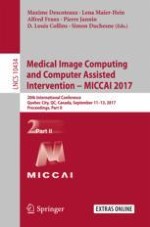2017 | Supplement | Buchkapitel
OptiC: Robust and Automatic Spinal Cord Localization on a Large Variety of MRI Data Using a Distance Transform Based Global Optimization
verfasst von : Charley Gros, Benjamin De Leener, Sara M. Dupont, Allan R. Martin, Michael G. Fehlings, Rohit Bakshi, Subhash Tummala, Vincent Auclair, Donald G. McLaren, Virginie Callot, Michaël Sdika, Julien Cohen-Adad
Erschienen in: Medical Image Computing and Computer-Assisted Intervention − MICCAI 2017
Aktivieren Sie unsere intelligente Suche, um passende Fachinhalte oder Patente zu finden.
Wählen Sie Textabschnitte aus um mit Künstlicher Intelligenz passenden Patente zu finden. powered by
Markieren Sie Textabschnitte, um KI-gestützt weitere passende Inhalte zu finden. powered by
